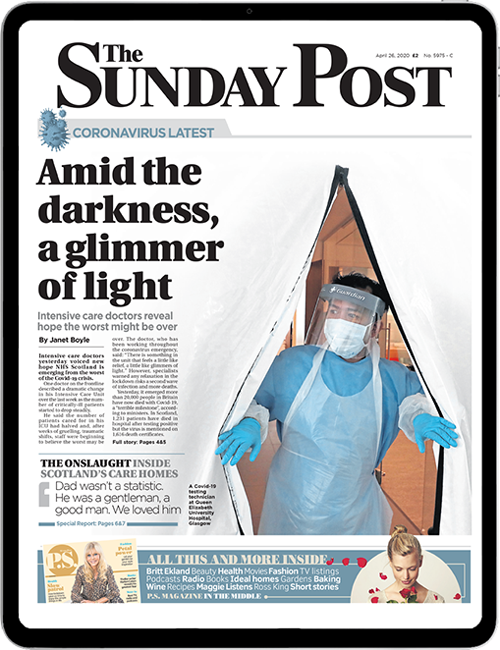
The pathologist examining a young mother after her sudden death was not told her abusive partner had a history of strangling her, The Sunday Post can reveal.
Dr John Clark admitted he may have taken “extra care” with the post mortem examination of Demi Hannaway, a serial victim of domestic abuse, if he had been given more information by police.
Her parents, Helen and John, accuse Police Scotland of rushing to decide she had taken her own life despite knowing her partner, Andrew Brown, had a recorded history of inflicting physical and psychological violence.
They are urging Justice Secretary Angela Constance to review the case and instruct Police Scotland and the Crown Office to launch an investigation.
Demi Hannaway’s death
At a meeting with her parents, Dr Clark admitted knowing nothing of the previous violence when conducting a post mortem examination after Demi died suddenly in May 2021.
Brown, who had previously throttled Demi when in a rage, claimed he had found her hanged in their bedroom but her family dismiss any suggestion the 23-year-old mother of two had been suicidal.
Just two weeks before her death, she had told her sister that Brown, who was flagged on police records as an abuser, had strangled her during what had been his most violent attack when she feared he was going to kill her.
Helen, who knew nothing of the abuse until after her daughter died, told The Sunday Post: “Of course, the pathologist should have known the background to our daughter’s death before her post mortem examination, it might have made a difference.
“Obviously, police should have told him. They should have done a lot of things but, in fact, did nothing at all.
“They did not investigate and they did not listen. Our daughter was failed at every stage by Scotland’s justice system. They did not make proper inquiries, allowed serious mistakes to lead to more, and ignored one red flag after another.”
Dr Clark, an experienced pathologist from Glasgow University, admitted he had been unaware of the previous abuse and could not rule out the possibility that Brown had used his forearm to throttle Demi or that she was unconscious before her death.
He did not notice anything suspicious during his examination but admitted he had not been looking for signs of violence possibly disguised by injuries caused by hanging.
The pathologist said tests that might have revealed if Demi had been unconscious before her death had been restricted during the pandemic and there had been no obvious reason to carry them out.
However, he said, he might have carried out further examination to establish if Demi had been starved of oxygen before her death if he had been aware of the background and her family’s concerns.
The pathologist was also not informed that punch marks had been found on the fridge at the couple’s house in Airdrie, where Demi’s hair was discovered on the floor along with flecks of blood on the walls.
Demi’s family had told officers about what looked like fingerprint bruising around Demi’s wrists after her death, a possible sign of struggle, but the pathologist said he had not seen them and police had not mentioned them.
A letter from the family’s lawyers, Livingstone Brown, supporting a formal complaint to Police Scotland that lists 32 alleged errors in the investigation, details the pathologist’s comments at the meeting.
The letter notes: “It became apparent during the course of the meeting that Dr Clark had not been provided with key information in respect of the circumstances surrounding Demi’s death.
“For example, Dr Clark accepted that he had not been made aware of the history of recorded domestic abuse between Demi and Andrew Brown. This was particularly important information, given the domestic abuse suffered by Demi was characterised by strangulation.
“Dr Clark accepted, during the course of the meeting, that he could not exclude the possibility that Andrew Brown had strangled Demi by placing his forearm on her throat and that, although he did not notice anything physically that would have suggested this, Demi could have been rendered unconscious by the placing of a forearm on her throat.
“Clark also accepted that it was possible that Demi’s injuries had been caused by strangulation.”
The letter concludes: “If the full background circumstances had been passed to Dr Clark, he may have taken additional steps during Demi’s post mortem, which, in turn, may have impacted his ultimate conclusions.”
Demi’s parents and their lawyer attended the online meeting in August last year with the pathologist and senior prosecutors from the Scottish Fatalities and Investigations Unit.
John said: “The pathologist is an experienced professional and defended his work. But, knowing what he knows now, he cannot be certain Demi took her own life and if he cannot be certain, why on earth were the police?
“We do not know what happened that night but we will never believe our daughter took her own life.
“We are not judge and jury but a judge and jury should have been allowed to decide what happened to Demi. They still should.”
Calls for urgent review
Her parents are urging ministers to order an immediate review after claiming Demi’s death was never properly probed.
They say police were far too quick to decide Demi had taken her own life in May 2021, despite knowing her violent partner had repeatedly attacked her.
Their formal complaint to Police Scotland accuses officers of deciding that Demi had killed herself within minutes of arriving at her home while ignoring circumstances which demanded further investigation.
The family highlight a range of issues that should have prompted inquiries, including contradictions in Brown’s statement, his history of abuse, and the discovery of Demi’s phone by her family after her death, hidden, smashed with the SIM card removed.
They also want to know why Brown’s admission that “it was all his fault” to an officer at the house was not followed up and did not prompt any consideration of charges relating to her death.
Brown, 33, was later jailed for sending Demi abhorrent abusive threats which were only discovered by her family when accessing her social media after her death.
He was jailed for 43 months at Airdrie Sheriff Court in May after he admitted threatening and abusive behaviour.
The Crown Office and Procurator Fiscal Service said: “We empathise with the deep distress and anguish of the family of Demi Hannaway following her tragic death. An investigation was carried out into the circumstances of Demi’s death, which took account of the background and concerns of the family, and it was concluded that no further action was required.
“We met with the family and the pathologist last year to discuss the investigation and its conclusions.”
Police Scotland said: “A complaint has been received and is being progressed by our Professional Standards Department.
“It would be inappropriate to comment further while this is ongoing, and a response will be sent to the complainers in due course.”
COMMENT: Red alerts mean case needs to be reopened
By Professor Jane Monckton Smith
Research overwhelmingly shows staged homicides have red alerts, just two or three of which should have police sealing the scene and dealing with a case like this as a suspected killing.
Virtually every possible red alert there is was present at the scene where Demi died.
Unexpected death, apparent suicide, a history of domestic violence, a history of non-fatal strangulation, rowing about separating, a suspected perpetrator having control of the scene and finding the body, and the death happening in the woman’s home or close by.
Just a couple of those red alerts should have resulted in Police Scotland sealing off the property, calling in forensics, and investigating the case as a possible staged homicide.
It’s deeply disappointing none of those procedures were followed in this case.
I believe hundreds of missed homicides every year are written off as suicides because investigators have failed to recognise the tell-tale signs.
I sincerely hope that this case is reopened and reinvestigated as a possible homicide, with all available evidence re-evaluated.
I am astonished that the pathologist who carried out Demi’s post-mortem was not informed about the history of domestic abuse this young mother was subjected to.
Every person who was involved in this case should have been informed about any history of domestic abuse. That knowledge is absolutely critical to how a case should be handled.
One of the reasons why so many perpetrators get away with it is because society is guilty of believing the myths spun to cover up the reality of domestic abuse. Cases are often put down to crimes of passion or mercy killings when they are, in fact, brutal murders.
Professor Jane Monckton Smith is a leading criminologist specialising in crimes against women

Enjoy the convenience of having The Sunday Post delivered as a digital ePaper straight to your smartphone, tablet or computer.
Subscribe for only £5.49 a month and enjoy all the benefits of the printed paper as a digital replica.
Subscribe © Gareth Iwan Jones
© Gareth Iwan Jones